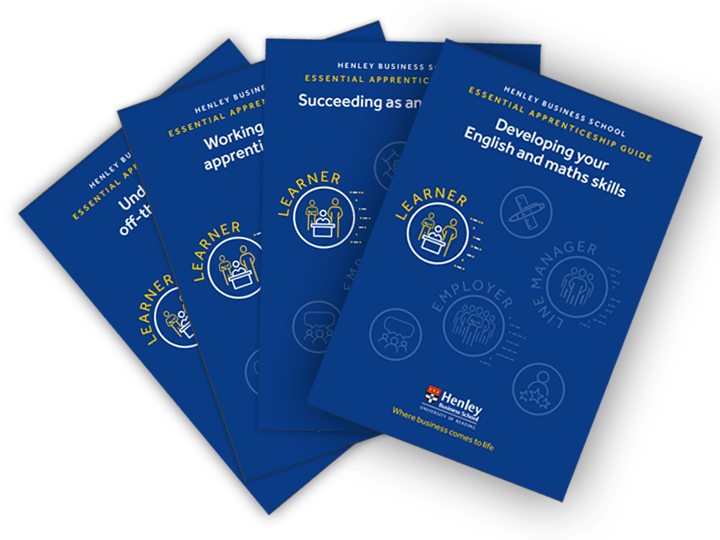Understanding off-the-job training
Learner | Employer | Manager
This guide explains the requirements concerning off-the-job training and how Henley works with clients to deliver impactful off-the-job training experiences.

Introduction
Meeting the off-the-job training requirement can be one of the more challenging aspects of apprenticeships. The Government requires all apprentices to spend at least six hours per week (equivalent) of their working hours in off-the-job training.
As a result, all apprentices and their employers must ensure that they record and evidence this. Meeting this requirement means that your apprentice and organisation will achieve maximum impact from the apprenticeship. Helping people to take a step back from their day-to-day work, to focus, learn and reflect, is a valuable approach that has always been at the heart of learning at Henley.
This guide summarises the requirements concerning off-the-job training and explains how Henley works with clients to deliver impactful off-the-job training experiences.
What is off-the-job training?
The Government defines off-the-job training as:
“Training which is received by the apprentice, during the apprentice’s normal working hours, for the purpose of achieving the knowledge, skills and behaviours of the approved apprenticeship referenced in the apprenticeship agreement.”
Off-the-job training must deliver new learning that is directly relevant to the apprenticeship. It can take place at the apprentice’s normal place of work, but it must not be part of their normal working duties.
The flowchart in Figure 1 helps determine what counts as off-the-job training.

“Organisations that provide high-quality development experiences are 1.5-times more likely to have high leader engagement and retention and twice as likely to be voted as best places to work.”Global Leadership Forecast, 2021
How much off-the-job training is required?
Apprentices must receive off-the-job training for at least six hours per week (equivalent) of their working hours. This requirement is calculated using your apprentice’s normal working hours over the planned duration of their apprenticeship (excluding their end-point assessment (EPA)). Apprentices will not be able to pass through Gateway, undertake an EPA or complete their apprenticeship until they have recorded the required amount of off-the-job training.
For more information on the apprenticeship process (including Gateway and EPAs), see Essential Apprenticeship Guide 1.1: Understanding higher and degree apprenticeships.
What off-the-job training do Henley apprentices receive?
Henley provides apprentices with a full programme of activities that deliver learning and contribute to the requirement for off-the-job training (see lower half of Figure 2 - click to enlarge). Typical activities include:
- Academic tutorials
- Meetings with the apprenticeship tutor
- Use of additional online resources (e.g. from the Chartered Management Institute)
- Work-based projects
- Work-based reflection
- Virtual learning (via Canvas)
- Attending workshops
- Writing assignments
In addition, the apprenticeship tutor works with your apprentice and their line manager to plan learning opportunities in the workplace (see upper half of Figure 2 - click to enlarge). These might include:
- 1-2-1s
- Attending and chairing meetings
- Conferences
- CPD training
- Performance reviews
- Professional discussion
- Providing cover with extra responsibilities
- Relevant employer events
- Shadowing colleagues
- ‘Stepping up’ – pro-actively seeking additional responsibilities
- Supply chain training
- Visiting other departments
How do we support you to meet off-the-job training requirements?
We assign an apprenticeship tutor to each apprentice. Their role is to support the development of the apprentice through regular contact, which includes helping them to apply their learning in the workplace. The apprenticeship tutor will also support them to create a plan for how they will achieve the required amount of off-the-job training. We encourage line managers to engage with the apprenticeship tutor to explore how they can facilitate opportunities for your apprentice to undertake any relevant off-the-job training.
In progress reviews, the apprenticeship tutor will also work with your apprentice and their line manager to measure the quantity and quality of their off-the-job training. This is to ensure it meets the needs of both the apprentice and the apprenticeship standard.
Recording off-the-job training
The employer, apprentice and training provider have a shared responsibility to ensure all off-the-job training is not only undertaken but is accurately recorded and regularly updated by your apprentice. All apprentices must be able to evidence that they have met the 6 hours per week (equivalent) off-the-job training requirement.
The apprenticeship tutor will show your apprentice how to record their off-the-job training, encouraging them to keep their records accurate and up to date. They will also regularly review how the amount of time recorded relates to the apprentice’s off-the-job training plan.
Going beyond the minimum
We encourage employers to look beyond the minimum requirement for off-the-job training. Organisations and apprentices benefit most from apprenticeship schemes when the apprentice can extend and implement their learning within their organisation.
Activities that count as off-the-job training can add huge value in stretching your apprentice’s learning and increasing their impact across your organisation.
Here are a few examples:
- Work shadowing or visiting other departments allows apprentices to experience other areas of your organisation and build relationships and networks.
- By stepping up for additional responsibilities, apprentices can develop personally and professionally, and can contribute to your succession planning strategy.
- Working with the supply chain can build organisational capacity as well as contribute to the apprentice’s development.
“Encourage apprentices to think of off-the-job training as a natural expression of continuing professional development. They should seize the opportunity to connect to communities of experts, become involved in professional networks and seek out new learning.”Dr Dorota Bourne
References
Global Leadership Forecast (2021) [Accessed 30 June 2021]
Gov UK (2019) On-the-job training flowchart. [Accessed 30 June 2021]
This site uses cookies to improve your user experience. By using this site you agree to these cookies being set. You can read more about what cookies we use here. If you do not wish to accept cookies from this site please either disable cookies or refrain from using the site.

